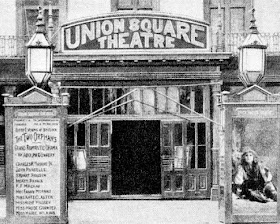In
Three Lives bookshop recently, I came across
The Lonely Phone Booth. Technically, it's for children, but anyone nostalgic for the city, and especially its lost phone booths, will enjoy it.
Publishers Weekly called it "Cultural history of the best sort."

The book was inspired by the venerable phone booth of West End Avenue and 100th Street. It is one of
four remaining outdoor phone booths in the city, but it's the only one that's been called "
an objet d'art...almost a religious edifice." That booth is beloved by many and has long been protected by a man named
Alan Flacks, who told the
Times, "people prefer actual booths where they can close the door, put their papers down on the shelf and
enjoy the amenities, such as shelter, privacy, light, and even security.''
Author Peter Ackerman agrees. I asked Mr. Ackerman some questions about his book. He answered.
 Q: What inspired you to write the tale of one of New York's last remaining phone booths?
Q: What inspired you to write the tale of one of New York's last remaining phone booths?A: I was walking past the phone booth with my sons, who were 6 and 3 at the time, and the 3 year old said "Why is that phone in a box?" It seemed so funny that he had no idea what it was. I've had some major life experiences in phone booths: calling my parents when I was cast in my first New York play, having endless discussions with my college girlfriend until I ran out of quarters, receiving collect calls from her while I was in a phone booth and she was in France (we got away with that a bunch of times until an operator broke through and said "I know what you're doing!" and cut us off.). And then I learned that there are only 4 proper phone booths left in Manhattan. So I found myself imagining what it must feel like to be one of those phone booths, once so central to people’s lives, but now on the verge of extinction.
 illustration by Max DaltonQ: What do you think we've lost as public pay phones have vanished, as people have come to rely on cell phones?
illustration by Max DaltonQ: What do you think we've lost as public pay phones have vanished, as people have come to rely on cell phones?A: It’s funny: it used to be that you could see people in pay-phones, but not hear what they were saying. Now you can hear people on cellphones but not always see them. There’s something more invasive about hearing someone else talking than there is watching a dumb show. I mean, phone booths are essentially transparent rooms where you could see someone laughing, crying, yelling, but not know the actual details. It allowed your imagination to engage with the community.
Now your imagination is invaded by someone else’s reality. It’s much more literal. So I think there was a genteel sharing of life’s experiences. In a soft-focus kind of way, you could recognize that someone was going through something without having the gory details take over your life. You also had the power to decide whether you wanted to think about them or not. Now, if you’re on a bus reading a book and someone is yakking away behind you, you have no choice but to stop reading and listen to half a conversation.
So I guess cellphones contribute to the loss of distinction between public and private space: the rest of the city should not HAVE to listen to your conversation.
 illustration by Max DaltonQ: There's a certain love of the analog in this book, and books, of course, are "analog" objects under siege from the digital. As a screenwriter (Ice Age) and now a book author, which medium are you rooting for? Or do you believe screen and page can coexist in the 21st century?
illustration by Max DaltonQ: There's a certain love of the analog in this book, and books, of course, are "analog" objects under siege from the digital. As a screenwriter (Ice Age) and now a book author, which medium are you rooting for? Or do you believe screen and page can coexist in the 21st century?A: I’m not really invested in one medium over another in an objective way. I love books because they’re one of the things I’m used to that gives me pleasure. But I love movies too and plays, music, art, etc... As for reading, itself, I would bet that by the end of the 21st century most people will read primarily digitally, because that's what those people will be used to.
A counter-argument is that I work on the computer all day, so at night, my eyes are too tired to watch TV or look at another screen. And I find reading actual books in the evening much more peaceful. But who knows what screens will look like in 50 years. Perhaps they’ll be equally peaceful to those readers.
I will say, though, that with kids, it’s wonderful to lie in bed with a book and turn the pages, see the pictures, put the bookmark in, look at the cover, see the books all lined up on the shelf. But again, it’s familiar to me.
Q: Do you see this book becoming a series starring other vanishing city objects? Will you do the story of the Lonely Parking Meter, the Lonely Old Newsstand, the Lonely [fill in the blank]?A: At the moment, no. There was something particular about the phone booth that struck me - the way it stands there in all weather as we walk past, occasionally seeing someone in it, feeling like it’s part of the neighborhood, physically, a noble old soul whom time is passing by, though he still has something to offer. But I’m not interested in general nostalgia trips.
The book is published by Godine, with illustrations by Max Dalton.

















































